#prehistoric predator fossil
Explore tagged Tumblr posts
Photo

Mosasaur Tooth Fossil in Matrix – Cretaceous Kem Kem Basin Morocco, Genuine Dinosaur-Age Specimen
A superb Mosasaur Tooth Fossil embedded in its original matrix, discovered in the Kem Kem Beds of the Cretaceous Period, near Khouribga, in the Kem Kem Basin, Morocco. This authentic specimen represents a tooth from one of the top marine predators of the Late Mesozoic era.
Mosasaurs were large marine reptiles closely related to modern monitor lizards and snakes. They dominated the seas during the Late Cretaceous, preying on fish, ammonites, and other marine life with their powerful jaws and robust conical teeth.
Fossil Type: Marine Reptile Tooth (Mosasaur)
Genus: Indeterminate Mosasaur (family Mosasauridae)
Geological Age: Lower Cretaceous – Aptian Stage (~125–113 million years ago)
Formation: Kem Kem Beds, Kem Kem Basin, Morocco
Depositional Environment: The Kem Kem Beds were formed in a river-dominated deltaic environment with periodic marine incursions. This rich ecosystem supported a diverse assemblage of both terrestrial and aquatic fauna, including dinosaurs, pterosaurs, fish, and marine reptiles like mosasaurs.
Morphological Features:
Thick, conical tooth with slight curvature
Well-preserved enamel and root (where present)
Naturally set in original sedimentary matrix for display
Notable:
Excellent example of a Cretaceous apex predator’s fossil tooth
Embedded in matrix for an authentic geological presentation
Perfect for collectors, educators, and fossil enthusiasts
The exact specimen in the photo is the one for sale
Authenticity: All of our fossils are 100% genuine natural specimens and are provided with a Certificate of Authenticity. The scale cube shown equals 1cm – please refer to the image for full sizing.
This Mosasaur tooth fossil from the Kem Kem Basin offers a direct connection to one of the most formidable marine reptiles of the dinosaur age—a fascinating and educational piece of ancient natural history.
#Mosasaur tooth fossil#fossil tooth in matrix#Kem Kem fossil#Cretaceous marine reptile#Moroccan Mosasaur tooth#dinosaur era tooth#tooth fossil Morocco#prehistoric predator fossil#reptile fossil Aptian#authentic Mosasaur fossil#collector fossil tooth#Kem Kem Beds fossil
0 notes
Text
Monday Musings: Who hunted Sauropods?
With the immense size of most sauropods it is hard to imagine what might have been brave enough (or stupid enough) to take one on. It seems unlikely but theropod tooth marks have been found on sauropod bones so we know they were being eaten at the very least.
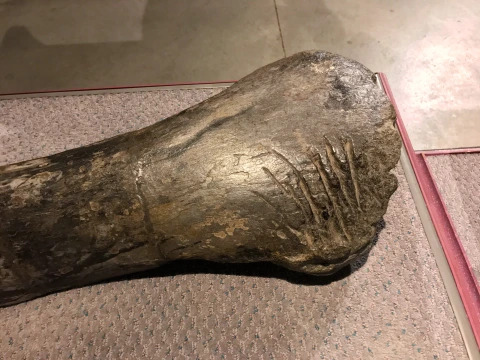
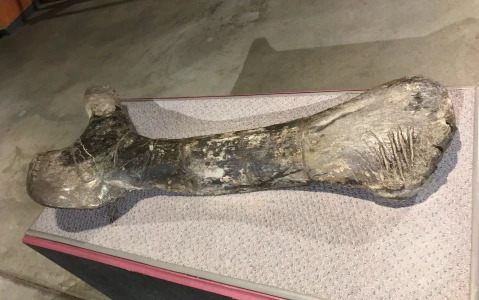
Mmm, Apatosaurus ischium.
Allosaurus is probably the most well-known of the sauropod predators. Often found alongside sauropod remains, it is highly likely that it hunted juveniles or sick adults in packs. One hypothesis for its hunting strategy is that it would use its head somewhat like an axe.

It had a relatively weak bite force but incredibly strong neck muscles. Its skull could withstand forces almost 15x that of its bite. They were also fast sprinters so they could ambush their prey. They would run up, use their massive, recurved claws on their hands as hooks to grapple prey much like raptors (meaning birds of prey, actual raptors) and then use their jaws to rake flesh off the sauropod causing it to bleed out. This allowed Allosaurus to follow behind at a safe distance while its prey bled to death.


Allosaurus vs Barosaurus
It is likely that cousins of Allosaurus such as Carcharodontosaurus, Giganotosaurus, and Mapusaurus also hunted sauropods in packs. All of these carnosaurs lived in sauropod heavy environments and had similar body plans that would allow them to hunt in similar fashions.
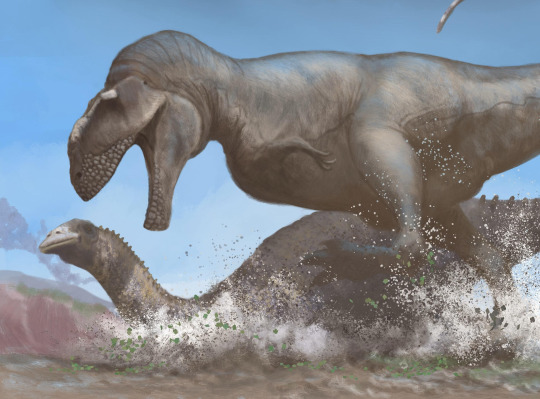
Carcharodontosaurus vs Rebbachisaurus by Mark Witton
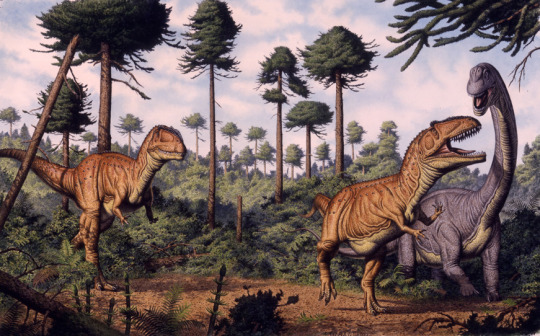
Giganotosaurus and Sauropod by Bob Walters and Tess Kissinger

Mapusaurus vs sauropods
It has also been suggested that abelisaurids like Majungasaurus were specialized for hunting sauropods. With short, broad snouts they might have hunted like modern felids: bite and hold on.

Majungasaurus tooth marks have been found on Rapetosaurus bones so we know they were eating sauropods at the very least.
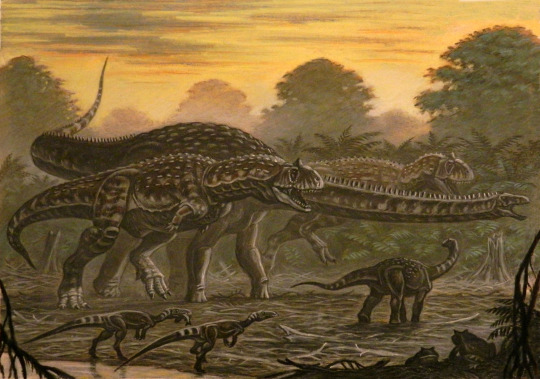
#paleontology#fossils#dinosaur#fun facts#allosaurus#sauropod#carcharodontosaurus#giganotosaurus#theropod#bite force#predator#prehistoric
42 notes
·
View notes
Text
#shark#orthacanthus#chondrichthyes#cartilaginous fish#fossils#elasmobranchii#marine predator#carnivore#predatory fish#shark species#predator#dinosaur#animal#prehistoric shark#fish#extinct#paleontology#underwater#marine animal#marine life#sea life#nature#sea#ocean#3d#illustration#coral#panorama
5 notes
·
View notes
Note
Hi! Love your blog! Wondering if you have any cool facts about quetzalcóatlus? I love prehistoric babies!
if you're a 90's kid like I was, probably your first exposure to the idea of the giant pterosaur Quetzalcoatlus was through the Dinotopia books! though the author/artist, James Gurney, did nickname them "Skybaxes" for the ease of young readers.

this gave us a beautiful picture of an amazing animal that we would later discover was, EXTREMELY misleading.
see, the first book was released in 1992, back when we only had a few wing bones to describe Quetzalcoatlus! they hinted at the existence of a giant pterosaur with the wingspan of a small plane, but they didn't offer much detail:

this is what James Gurney was working off of when he created the Skybax, and you can totally see where he came from! he basically took the body plan of known pterosaurs like Pteranodon and scaled it UP to match the size of the new fossils.
but over the next several years, new fossils of Quetzalcoatlus were being discovered, described, and cataloged, enough that Gurney created a new Quetzalcoatlus for his second Dinotopia book that was outright stated to be Quetzalcoatlus Northropi, which is the name of the actual animal these bones belong to!
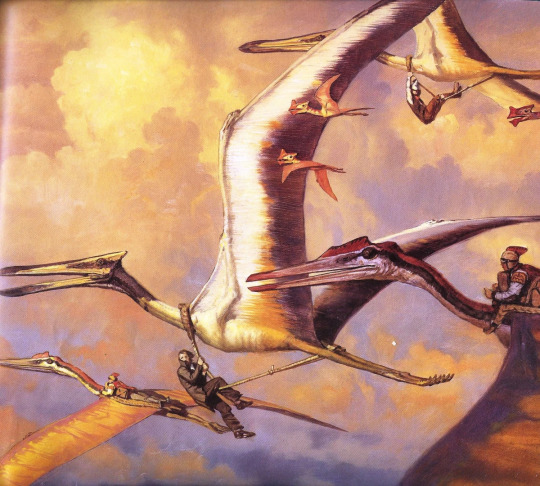
so sized up even bigger, same body plan.
and then in the early 2000's, some very interesting discoveries started to be made about Quetzalcoatlus and its relatives! turns out that they were a bunch of giraffe-sized storkmonster predators that could probably 1v1 a T Rex.
shown here life size!

so needless to say, this was a bit of a shock.
but MAN. just goes to show, if you can imagine an animal, nature already made something 1000% crazier and more badass. and it probably wants to eat you.
6K notes
·
View notes
Text
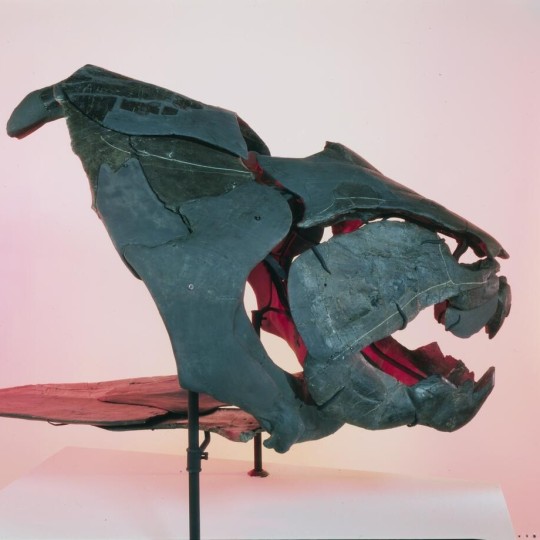
Don’t mess with this fish! For Fossil Friday, let’s meet Dunkleosteus terrelli. It lived some 360 million years ago during the Devonian. Scientists think it was one of the first large jawed vertebrates in the ocean and an aggressive predator. The razor-sharp edges of bones in its jaws served as cutters, and as they rubbed against each other, the opposing jaw blades acted like self-sharpening shears. These bones continued to grow as they were worn down by use.
This specimen, on display in the Museum’s Hall of Vertebrate Origins, was found in Ohio. Spot Dunkleosteus and other prehistoric animals at the Museum! Plan your visit.
Photo: Image no. ptc-5861 © AMNH Library
#science#amnh#museum#fossil#nature#natural history#animals#fact of the day#did you know#fish#fossil friday#fossil fish#prehistoric#devonian#museums#american museum of natural history#museum of natural history#natural history museum#paleontology
710 notes
·
View notes
Text
Imagine yourself submerged in the prehistoric ocean. There are no fish, instead the only life forms consist of feather-like sessile organisms that sit on the seabed, filtering the current. The early organisms that evolved out of this, such as Jellyfish and Starfish, had radial anatomy. Their body structure entails a central axis from which you can split everything else. These bodies are simple, not designed for active mobility, lacking a ‘forwards’ or ‘backwards’. They didn’t even have eyes, instead interacting with and responding to the world via photoreceptive cells. What emerged from this were two developments: the evolution of complex eyes and the emergence of bilateral anatomy in early vertebrates and arthropods. In contrast to radial anatomy, bilateral anatomy entails an organism that can be split down the middle with rough symmetry. This is to say that they are built for direction. A body that is built for mobility entails significantly more complex behaviour behind its operation. Behaviour, in this sense, also becomes significantly more directed. These creatures now living in the ocean or on the sea-floor now begin to directly interact with one another. The mechanisms facilitating this interaction become pretty apparent in the fossil record; eyes, claws and antennae. The evolutionary consequences of this are the emergence of a complex nervous system alongside the presence of predation and, as Godfrey-Smith puts it “[From this point on] The mind evolved in response to other minds”.
556 notes
·
View notes
Text
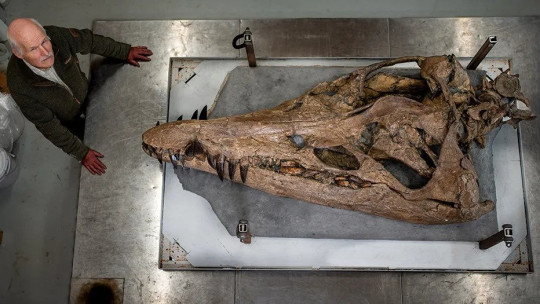
Gigantic Skull of Prehistoric Sea Monster Found on England’s ‘Jurassic Coast’
The remarkably well-preserved skull of a gigantic pliosaur, a prehistoric sea monster, has been discovered on a beach in the county of Dorset in southern England, and it could reveal secrets about these awe-inspiring creatures.
Pliosaurs dominated the oceans at a time when dinosaurs roamed the land. The unearthed fossil is about 150 million years old, almost 3 million years younger than any other pliosaur find. Researchers are analyzing the specimen to determine whether it could even be a species new to science.
Originally spotted in spring 2022, the fossil, along with its complicated excavation and ongoing scientific investigation, are now detailed in the upcoming BBC documentary “Attenborough and the Jurassic Sea Monster,” presented by legendary naturalist Sir David Attenborough, that will air February 14 on PBS.

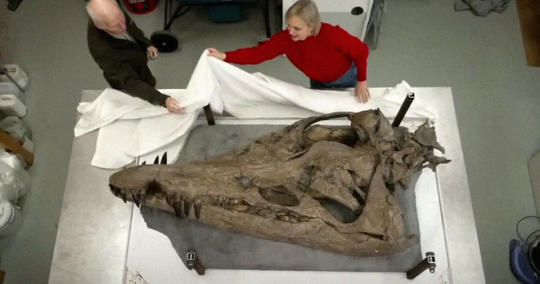
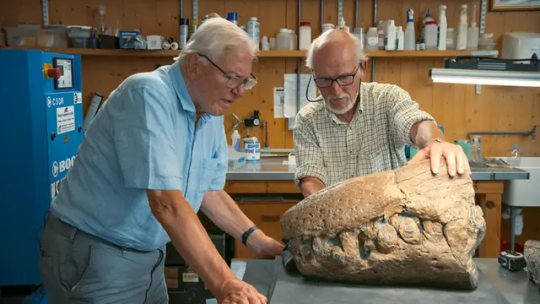
Such was the enormous size of the carnivorous marine reptile that the skull, excavated from a cliff along Dorset’s “Jurassic Coast,” is almost 2 meters (6.6 feet) long. In its fossilized form, the specimen weighs over half a metric ton. Pliosaurs species could grow to 15 meters (50 feet) in length, according to Encyclopaedia Britannica.
The fossil was buried deep in the cliff, about 11 meters (36 feet) above the ground and 15 meters (49 feet) down the cliff, local paleontologist Steve Etches, who helped uncover it, said in a video call.
Extracting it proved a perilous task, one fraught with danger as a crew raced against the clock during a window of good weather before summer storms closed in and the cliff eroded, possibly taking the rare and significant fossil with it.
Etches first learned of the fossil’s existence when his friend Philip Jacobs called him after coming across the pliosaur’s snout on the beach. Right from the start, they were “quite excited, because its jaws closed together which indicates (the fossil) is complete,” Etches said.
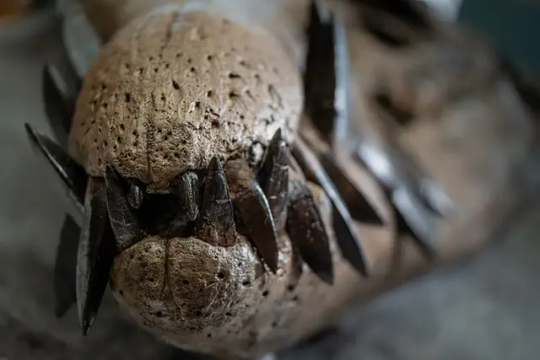
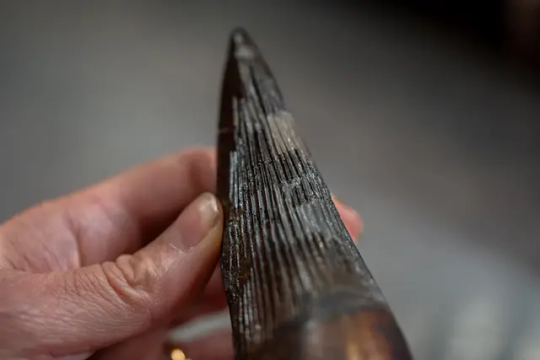
After using drones to map the cliff and identify the rest of the pliosaur’s precise position, Etches and his team embarked on a three-week operation, chiseling into the cliff while suspended in midair.
“It’s a miracle we got it out,” he said, “because we had one last day to get this thing out, which we did at 9:30 p.m.”
Etches took on the task of painstakingly restoring the skull. There was a time he found “very disillusioning” as the mud, and bone, had cracked, but “over the following days and weeks, it was a case of …, like a jigsaw, putting it all back. It took a long time but every bit of bone we got back in.”
It’s a “freak of nature” that this fossil remains in such good condition, Etches added. “It died in the right environment, there was a lot of sedimentation … so when it died and went down to the seafloor, it got buried quite quickly.”
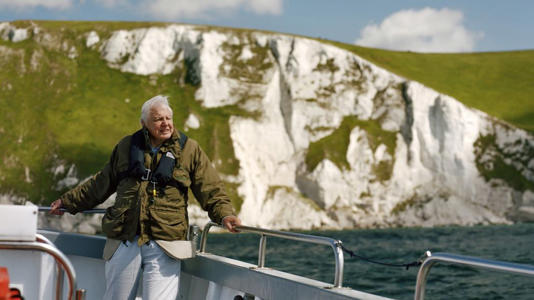
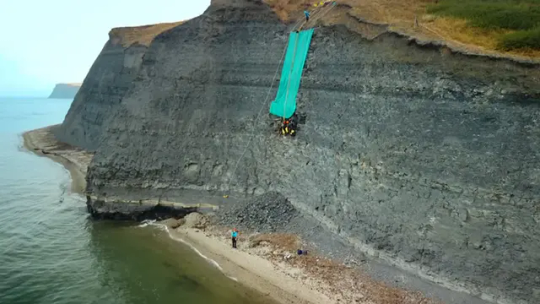
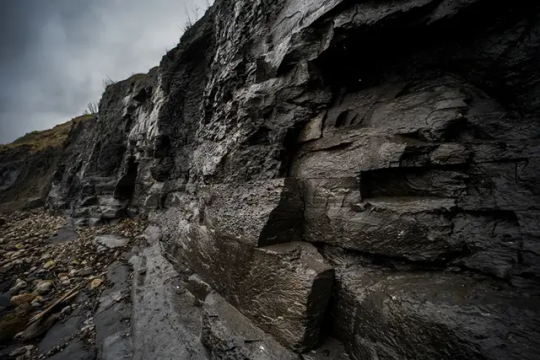
Fearsome top predator of the seas
The nearly intact fossil illuminates the characteristics that made the pliosaur a truly fearsome predator, hunting prey such as the dolphinlike ichthyosaur. The apex predator with huge razor-sharp teeth used a variety of senses, including sensory pits still visible on its skull that may have allowed it to detect changes in water pressure, according to the documentary.
The pliosaur had a bite twice as powerful as a saltwater crocodile, which has the world’s most powerful jaws today, according to Emily Rayfield, a professor of paleobiology at the University of Bristol in the United Kingdom who appeared in the documentary. The prehistoric marine predator would have been able to cut into a car, she said.
Andre Rowe, a postdoctoral research associate of paleobiology at the University of Bristol, added that “the animal would have been so massive that I think it would have been able to prey effectively on anything that was unfortunate enough to be in its space.”
By Issy Ronald.
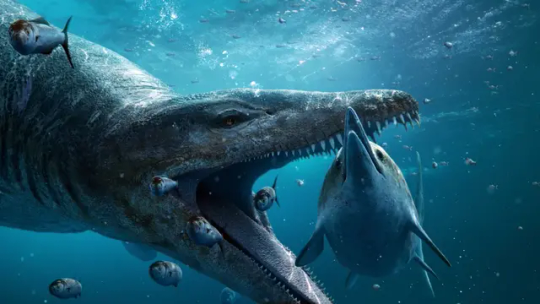
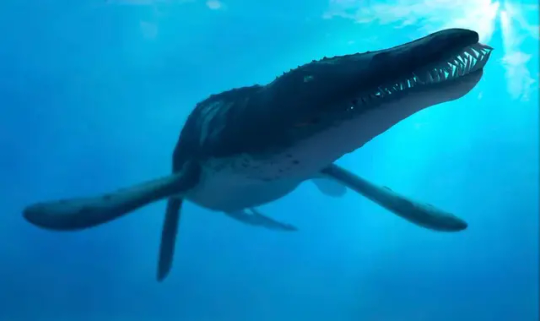
#Gigantic Skull of Prehistoric Sea Monster Found on England’s ‘Jurassic Coast’#Dorset England#pliosaur#jurassic#fossil#prehistoric#dinosaur#paleobiology#palaeontologists#archaeology#archeolgst#history#history news#ancient history#Sir David Attenborough#nature#naturalist
2K notes
·
View notes
Text
Archovember 2024 Day 26 - Compsognathus longipes
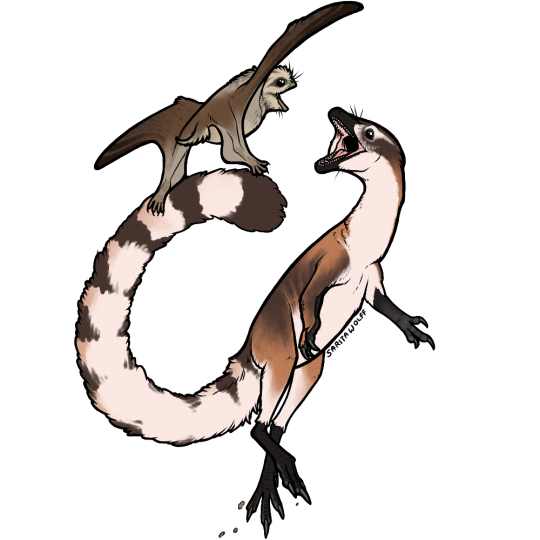
Before it was confirmed that birds were dinosaurs, Compsognathus longipes was regarded as the smallest dinosaur for decades. About the size of a chicken, its name means “elegant/refined/dainty jaw”. It lived in Late Jurassic Europe, found thus far in both Germany and France, with possible teeth also found in Portugal. It was carnivorous, and the remains of small lizards were found preserved in both fossil specimens. They were likely fast, scurrying animals, using their long tails for balance.

In the Late Jurassic, Europe was a dry, tropical archipelago at the edge of the prehistoric Tethys Sea. Both Compsognathus specimens were preserved within lagoons, possibly having died chasing lizards on the beach and then being swept out to sea in a flash flood. The German specimen is known from the Painten Formation, a part of the Solnhofen Limestone. The French specimen was found in limestone on the plateau of Canjuers. One of Compsognathus’ most famous contemporaries is the avialan Archaeopteryx, and the two may have competed over prey. It would have also lived alongside early pterosaurs like Propterodactylus, Rhamphorhynchus, and Anurognathus (as seen above). There were also a diverse variety of turtles, rhynchocephalians, and lizards living here as well, many of which served as prey for this tiny, catlike predator.

This art may be used for educational purposes, with credit, but please contact me first for permission before using my art. I would like to know where and how it is being used. If you don’t have something to add that was not already addressed in this caption, please do not repost this art. Thank you!
#Compsognathus longipes#Compsognathus#compsognathid#theropods#saurischians#dinosaurs#archosaurs#archosauromorphs#reptiles#Archovember#Archovember2024#Dinovember#Dinovember2024#SaritaDrawsPalaeo#Late Jurassic#Germany#France#Portugal#Painten Formation#Solnhofen Limestone#Solnhofen Limestone Formation
149 notes
·
View notes
Text
Literally nobody asked for this
Whb au where everything's the same but the demons have dinosaur forms
Something something that one girl Duna from Fossil fighter is something something
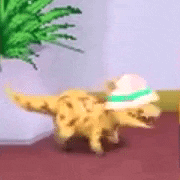
AU background:
Instead of the demons being demons and this alternate universe taking place in hell, it takes place in another world entirely, where dinosaurs can shift into a more humanoid form. Seven clans rule over this prehistoric world. Instead of houses, these weird Dinosaur shifters live in dug-out dens with soft leaves and pelts like cavemen as bedding for their nests.
They seem to know how to make and use tools but prefer the thrill of the hunt.
You are the first human they have seen in a long time. Apparently, humans are so rare that they are considered extinct.
Human smell nice :) human make good den-mate...
Satan (Utahraptor)
Big angry flood, The smallest of the kings but still an Apex predator of the jungle. He is truly a force to be reckoned with as he protects his fellow raptors of the Gehenna Clan with his own life.
When he sees you as part of his pack, who protects you with his life, and when you see him and his pack hunting together to catch prey, it reminds you of a biker gang.
He transforms into his humanoid form thanks to his white feathers and hair. He's always staying the red with the blood of his latest kills.
He and The Gehenna Clan live in an open prairie and woodlands where the wet season is short yet dramatic, causing large floods, and the dry seasons are long enough to be considered semi-arid. Despite having the heart of the clan being where the majority of their nesting spots are, you could still find plenty of temporary and backup dens all around their territory. They love to move around, and you have to when you want to and need to find herds of moving prey and water.
Mammon (Gigantosaurus)
The most lush and diverse territory of the clans. They have meat, they have fruit. They even have luxurious goods to trade with the other clans. No wonder that they are considered the wealthiest. And with an understanding of tool use, they're considered ahead of their time in semi-fantasy prehistoric standards.
However, your tales of the land you come from fascinate him. You don't seem to be lying. You even showed him proof, a little screen device that his claws almost broke when he had it in his hands.
He likes how small and soft you are compared to him; even in his human form,, he towers over you. He likes that you curiously poke and prod at his tail and the little feathers that stick out of his shoulders.
Even he has rarely seen humans, and you're just so cute, like a little pet, an exotic pet. He will offer you everything that the Tartaros Clan has to offer. If that's not your liking, He has 100% confidence that he and his subordinates will put the resources and time to replicate anything you desire from your world.
Leviathan (Spinosaurus)
Hades is a perfect mix of land and water, whether a forest with plenty of rivers, lakes, or swamps. It is a subtropical region with so much humidity that it feels like you're drowning. It's wet, rainy, and foggy most of the time.
The heart of the Clan and any place with dens usually lay the floor with cold stone. That makes living in the clan far better. They take great pride in their dens.
Of course, there are spinosaurus rulers. The ruler has the biggest and most luxurious den. In a hidden cavern past a waterfall, he hides away in a cozy subterranean lake glittering with crystals. He is constantly taking care of and maintaining his den.
He only recently started adding more pelts to make his otherwise cold den more habitable after catching wind that a human had appeared.
Beelzebub(Gigantoraptor)
He may look friendly, but beware. His dinosaur form is not only huge, but gigantoraptors eat plants and meat. And this one is not picky.
In a temperate forest, the Abyssos Clan is very well known for its plentiful sweet fruits, especially fruits that like to ferment and spoil into a blend that causes one to get intoxicated. The shifters from the Abyssos constantly store these fruits in old barrels before burying them.
With food being so plentiful, they are not picky eaters. They'll eat anything they find, whether it's the first they grow or the vermin that eat them.
Usually, the oviraptorosaurs that make up the clan stay in either small groups or in the heart of the clan. However, the clan's leader prefers a more roaming, solitary lifestyle.
Lucifer(Smilodon)
You have seen very few prehistoric mammals. Other than Lucifer, Beleth is a white cave lion. You wonder why only those two and no one else you've seen.
According to Lucifer, there were many more prehistoric mammal shifters and humans until something seemed to have happened. He also had brothers, but he refused to talk about them.
The Paradise Clan is the most versatile, with climate and biome in their territory, as well as the most diverse dinosaur shifters. From strictly herbivores to carnivores to anything in between, all of them have something in common.
A very advanced knowledge of medicine and medicinal herbs. And their leader seems to be extremely curious about your human nature.
Belphegor(Yutyrannus)
With the finest furs and his fluffy down, he is out like a light in minutes. Like many shifters, he surrounds himself with our dinosaurs, which work well in packs, very smart raptors, and therapods.
Their fluffy little tyrant mostly just shoves the work off, too. His poor cave lion subordinate rules it like a pride.
He never really slept much in his human form. He did one night cuddling you, and now he's addicted. His favorite part is when his tail wraps around your leg, and your sweet scent picks up on his sensitive nostrils when he buries his nose into your skin.
He likes to lay his big ass Dino form head on you and squish you grumble about how comfy you are as you beat on his feathery skin and yell.
Asmodeus (Tyrannosaurus Rex)
It may seem weird at first, but trust. According to research, Tyrannosaurus was not only a pretty good parent but also a very sensitive lover.
The tip of her nose is as sensitive as a human's hand, and they likely used it in courtship (Google says prehistoric foreplay; I will not be using that for obvious reasons). Although not the biggest of the apex predators being labeled as it will immediately get to his head.
Abbaddon clan has the most diverse pack of Dino shifters besides Paradise Lost. The majority are outcasts and very dangerous dinos. Abbaddon rests between a cascading mountain range closed off from the rest of the world in a calm little valley near the coast. With lots of yummy fruit trees, warm tropical weather, plenty of filling prey, and company just like them, Why would they leave?
His personal paradise All he wants now is a mate, and he'll be complete
60 notes
·
View notes
Text
You know what it's time for?
WEIRD SHARKS THAT'S WHAT IT'S TIME FOR
(IDs are in the image descriptions)
Pocket Shark
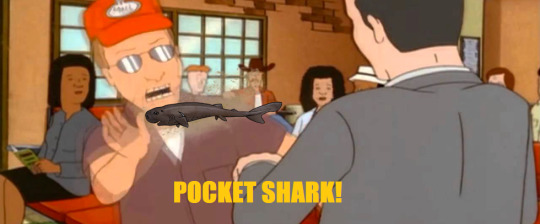
Pocket sharks are named for two small pocket glands appearing behind their pectoral fins. These glands are theorized to be luminous. Pocket sharks look like tiny, tiny sperm whales.
Angular Roughshark

Also called the pig-faced shark or the pig fish, angular roughsharks grow to be about 3 feet 4 in long on average. I personally think they're more bat-faced.
Goblin Shark

Found in the deep sea, goblin sharks are known for being able to extend their jaws like a grabber tool made of teeth. Wikipedia says that these sharks' "flabby bodies" suggest that they are sluggish in nature.
Cookiecutter Shark
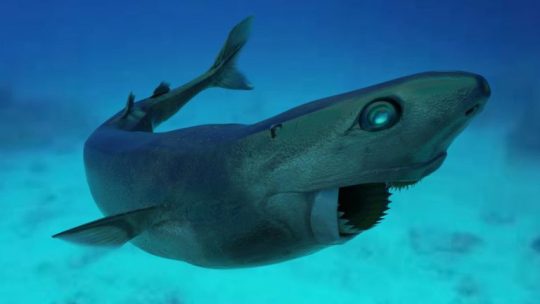
The cookiecutter shark only grows to about 20 inches in length, but that doesn't stop it from biting into orcas, great whites, or humans. It suctions onto its meal with its lips and then goes to town. It removes perfect circles of flesh, hence its name.
Wobeggong Shark
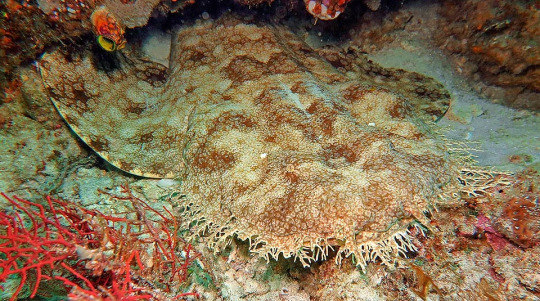
Wobeggong refers to twelve species of carpet shark, so-named for their resemblance to a shag rug. They dwell on the bottom of the sea floor and wait for smaller fish to swim nearby.
Swell Shark
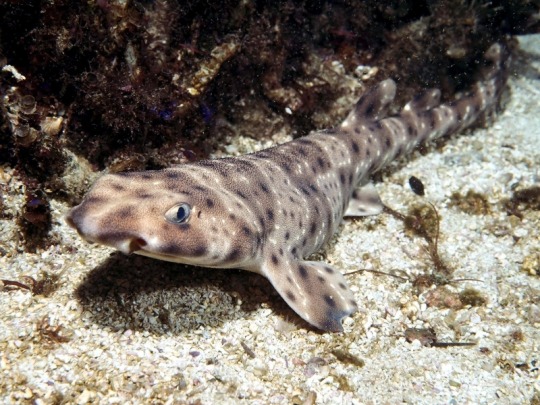
Swell sharks like to hide in crevices of algae-covered rocks, waiting for prey to swim by. They are so named not because they're really swell (though they are) but because as a defense mechanism, they can swell up to double their size by swallowing sea water.
Greenland Shark
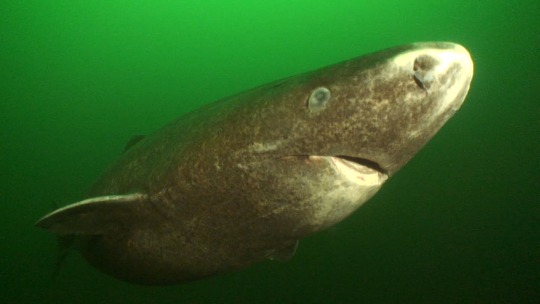
The Greenland shark has high concentrations of urea in its body. It is theorized to have a lifespan of 250 to 500 years, and it can grow up to 23 feet long. Greenland sharks have been found with moose and reindeer in their stomachs. Because of the shark's toxic levels of urea, its flesh must be fermented or otherwise treated before consumption.
Viper Dogfish
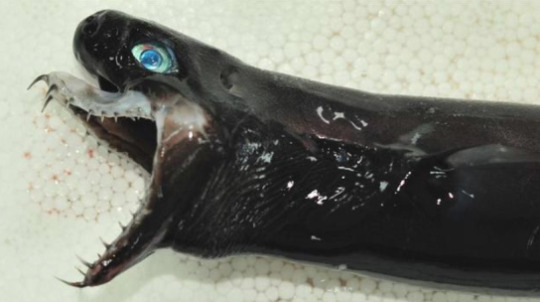
Like the goblin shark, the viper dogfish's jaws can protude from the rest of its head, though its coloring means the viper dogfish looks significantly more Xenomorphish when doing so. This small shark is a member of the lanternshark family, and its underside glows.
Pointy-Nosed Blue Chimaera
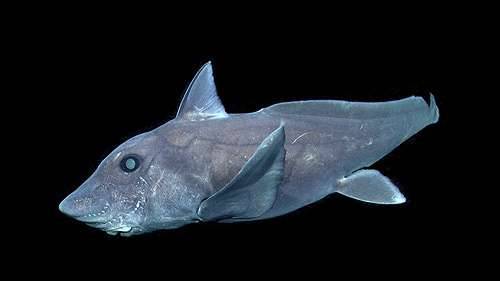
Also know as the abyssal ghostshark, this deep sea shark has a venomous spine on its dorsal fin used for defense.
Genie's Dogfish Shark
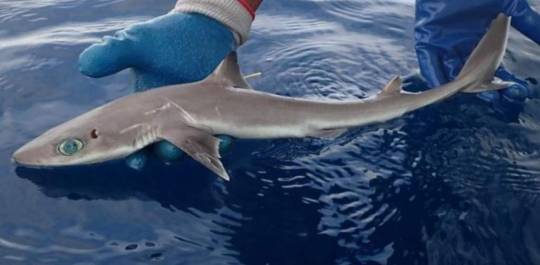
Genie's dogfish shark is a small species found in the gulf of Mexico and the west Atlantic Ocean. It has real life anime eyes.
Ninja Lanternshark
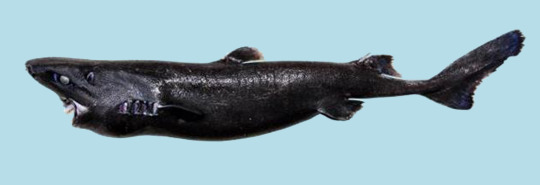
The ninja lanternshark is a small bioluminescent shark. It is all black except for white markings around its eyes and mouth. It reaches about a foot and a half in length.
Frilled Shark
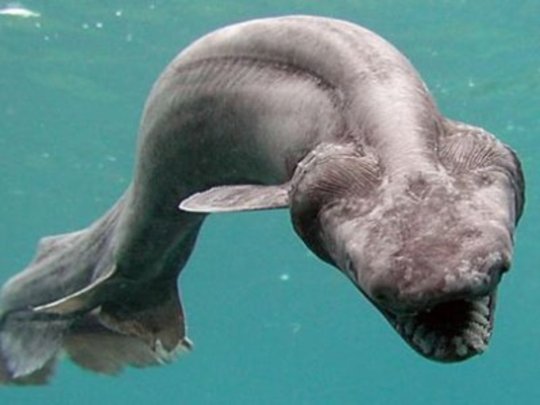
The frilled shark is sometimes called a living fossil, as it is basically unchanged in the past 80 million years. They are named for their teeth, which each have three points.
Epaulette Shark
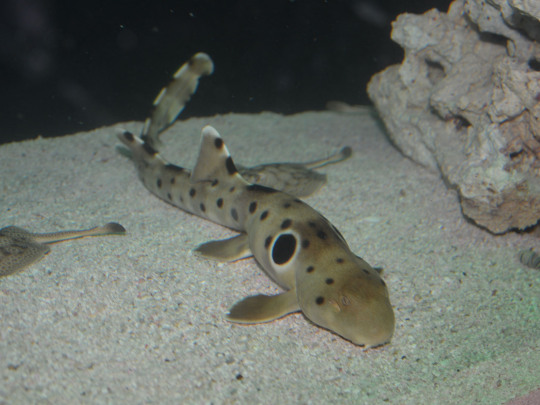
Epaulette sharks are named for the large spots behind their pectoral fins. These sharks frequently visit tidal pools and have adapted to long periods of oxygen deprivation by shutting down non-essential neural functions. Epaulette sharks often "walk" with their fins on the sea floor rather than swim.
Horn Shark
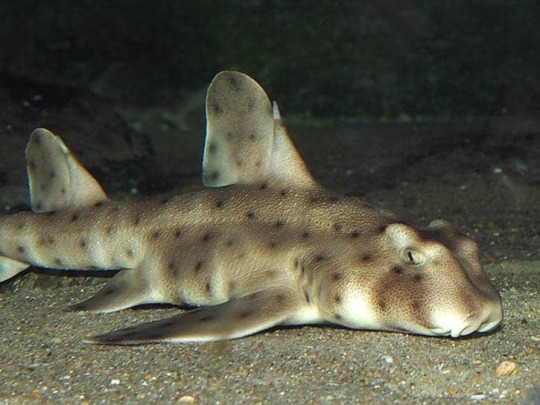
Similar to the epaulette sharks, horn sharks like to walk on the sea floor with their fins. However, these sharks have sharp spines to deter predators.
This Ridiculousness
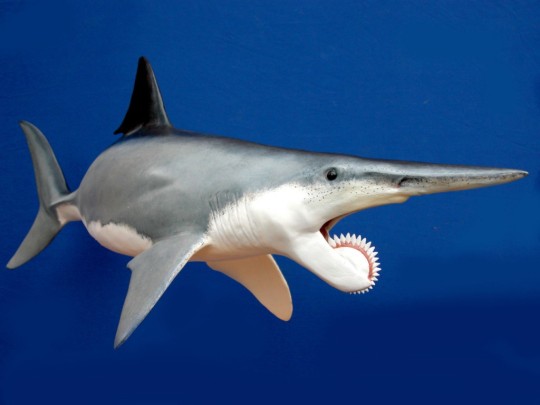
A prehistoric shark, helicoprion lived 20 million years ago and was apparently part buzzsaw. A fossil unearthed in Idaho in 2014 showed that these sharks had no teeth in their upper jaw, and a whorl of teeth in their lower jaw. It's a shame Junji Ito wasn't introduced to this shark during the writing of Uzumaki.
1K notes
·
View notes
Text
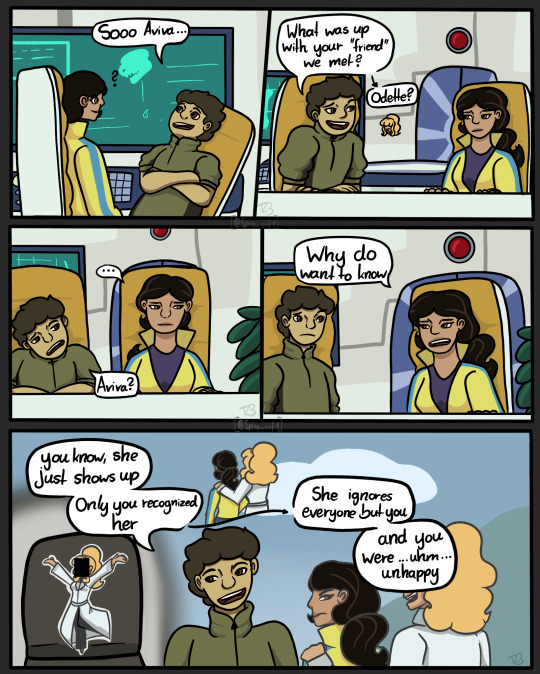
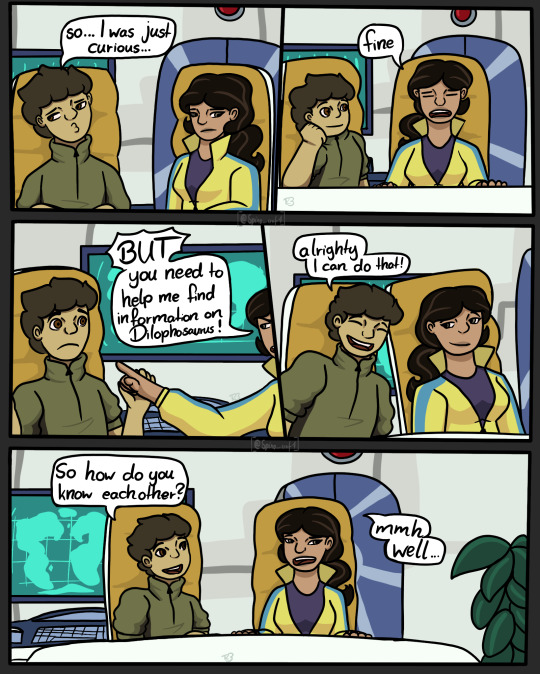

Funfact: Tyrannosaurus Rex might have been the tyrant king of the Mesozoic era but they weren’t undefeated. Fossil records show that an adult triceratops was not only capable of surviving an attack but also win and sometimes kill a T-Rex in battle, which means that they were one of the few animals that could kill a otherwise undefeated predator
#wild kratts#martin kratt#chris kratt#digital art#wild kratts au#dinosaur#aviva corcovado#wild kratts fan comic#wild kratts oc#wildkratts au#fan comic#thylacoleo#Oc lore time#I defo didn‘t forget about her
43 notes
·
View notes
Photo

Mosasaur Tooth Fossil in Matrix – Cretaceous Kem Kem Basin Morocco, Genuine Dinosaur-Age Specimen
A superb Mosasaur Tooth Fossil embedded in its original matrix, discovered in the Kem Kem Beds of the Cretaceous Period, near Khouribga, in the Kem Kem Basin, Morocco. This authentic specimen represents a tooth from one of the top marine predators of the Late Mesozoic era.
Mosasaurs were large marine reptiles closely related to modern monitor lizards and snakes. They dominated the seas during the Late Cretaceous, preying on fish, ammonites, and other marine life with their powerful jaws and robust conical teeth.
Fossil Type: Marine Reptile Tooth (Mosasaur)
Genus: Indeterminate Mosasaur (family Mosasauridae)
Geological Age: Lower Cretaceous – Aptian Stage (~125–113 million years ago)
Formation: Kem Kem Beds, Kem Kem Basin, Morocco
Depositional Environment: The Kem Kem Beds were formed in a river-dominated deltaic environment with periodic marine incursions. This rich ecosystem supported a diverse assemblage of both terrestrial and aquatic fauna, including dinosaurs, pterosaurs, fish, and marine reptiles like mosasaurs.
Morphological Features:
Thick, conical tooth with slight curvature
Well-preserved enamel and root (where present)
Naturally set in original sedimentary matrix for display
Notable:
Excellent example of a Cretaceous apex predator’s fossil tooth
Embedded in matrix for an authentic geological presentation
Perfect for collectors, educators, and fossil enthusiasts
The exact specimen in the photo is the one for sale
Authenticity: All of our fossils are 100% genuine natural specimens and are provided with a Certificate of Authenticity. The scale cube shown equals 1cm – please refer to the image for full sizing.
This Mosasaur tooth fossil from the Kem Kem Basin offers a direct connection to one of the most formidable marine reptiles of the dinosaur age—a fascinating and educational piece of ancient natural history.
#Mosasaur tooth fossil#fossil tooth in matrix#Kem Kem fossil#Cretaceous marine reptile#Moroccan Mosasaur tooth#dinosaur era tooth#tooth fossil Morocco#prehistoric predator fossil#reptile fossil Aptian#authentic Mosasaur fossil#collector fossil tooth#Kem Kem Beds fossil
0 notes
Text
Most of the paleo-inaccuracies (if not all) in the Jurassic Park franchise can be blamed on one key factor: Frog DNA.
How can the dinosaurs change sex? Frog DNA.
Why could some dinosaurs roar? Frog DNA.
Why do all the theropods have "broken" wrists? Frog DNA.
Why do all the dinosaurs have some level of shrink-wrapping? Frog DNA.
Why was the dilophosaurus below its actual height? Frog DNA.
Why did dinosaurs like Gallimimus, Atrociraptor, and Velociraptor not have feathers? Frog DNA.
Why was the Tyrannosaurus' bite force so weak compared to its real life counterpart? Frog DNA.
Why did the Ankylosaurus lose to the Indominus Rex when it was strong enough to handle its own? Frog DNA.
Why did the JP tyrannosaurus have bad eyesight? Well in the book, its supposed to be frog DNA. In the movie, its exposition given by Dr. Grant.
Why did carnivorous dinosaurs around the height of T. rex hunt smaller prey even though gigantism should have prevented that? Frog DNA. Remember, frogs eat bugs which are much smaller than them.
Why does Baryonyx look nothing like its fossilized skeleton suggests? Frog DNA and possible crocodilian DNA.
Why were the Pteranodons so aggressive and featherless? Frog DNA.
Why is the JW & Rebirth Mosasaurus much bigger than it should be? I'm assuming Frog DNA. It is considered its own species.
Why was the JP3 Spinosaurus hyper-aggressive and very different compared to how it should be according to paleontology? Frog DNA, additional gene modifications, and because Dr. Wu and the other JP scientists didn't realize what the actual spinosaurus looked like, so the previous more paleo-accurate clones they made were discarded to Isla godknowswhere.
Why could dilophosaurus spit venom? Frog DNA...somehow. According to the Masrani Global website, Yellow-banded Poison Dart Frogs were the most compatible with Dilophosaurus DNA. So Frog DNA yes, but somehow that gave it the ability to shoot venom, and have frills.
How come Atrociraptor shares a similar height to Velociraptor Antirrhopus (aka Deinonychus)?...not Frog DNA but Isla Sorna Velociraptor DNA (I'm assuming the Tiger Stripes from TLW due to their aggression) which has frog DNA. Yeah these are hybrid raptors according to dinotracker.com. Although that is debatable considering BioSyn's dinosaurs are supposedly pure. But that would explain why they sound like raptors in Chaos Theory.
How come Pyroraptor exhibits traits of winter predators even though it likely didn't live in those conditions in the first place? I have no idea...BioSyn made these guys. Penguin DNA I assume?
But things such as the velociraptors being tall, smart, pack hunters, are attributes from deinonychus. And Velociraptor is deinonychus, or at least it is in the books. Long story short, Velociraptor antirrhopus is the full species name for the book version of the raptors, not Velociraptor mongoliensis. This is because in the book universe, deinonychus is considered velociraptor, and not its own genus. Thank you, Michael Crichton for making Velociraptors 10x more confusing than needed to be. I don't think Deinonychus was that intelligent and they only formed packs sometimes to take down larger prey
Other than that issue, most dinosaurs in Jurassic Park have some level of difference compared to their real life counterpart. Hope this helps some people who get upset everytime a dinosaur, flying reptile, or other prehistoric creature is shown with inaccurate details in this franchise. And please note that several types of frogs may have been used in the creation of these dinosaurs. Just because Dilophosaurus had DNA that was most compatible with that of a poison dart frog's doesn't mean the Reed Frog (the african frog that Dr. Grant theorized the JP scientists were using) wasn't used in dilophosaurus' modified genome.
#jurassic park#the lost world jurassic park#jurassic park 3#jurassic park ///#jurassic world#jurassic world fallen kingdom#jurassic world dominion#jurassic world rebirth#jurassic world camp cretaceous#jurassic world chaos theory#dinosaurs#tyrannosaurus rex#gallimimus#velociraptor#atrociraptor#pyroraptor#michael crichton#ankylosaurus#spinosaurus
35 notes
·
View notes
Text
#shark#edestus#chondrichthyes#fossil#marine predator#carnivore#predatory fish#shark species#predator#dinosaur#animal#prehistoric shark#fish#extinct#paleontology#underwater#marine animal#marine life#sea life#nature#sea#ocean#3d#illustration#jumping
0 notes
Note
Ironstrange Dinosaur AU
(YouTube fed me with Jurassic Park and Jurassic World shorts while I was trying to study, so here I come; since you're very aware of my obsession with turning everything into Ironstrange)
Tony is a T. rex and Stephen is a Spinosaurus. Enemies to lovers.
Went for a magical mishap instead of a full dinosaur AU.
Tony, the six-ton apex predator, was sulking.
Well, as much as a T. rex could sulk. Which is to say, he was stomping in circles around a patch of ferns, muttering to himself while occasionally snapping at a dragonfly like it owed him child support.
“This is your fault,” he grumbled, trying and failing to scratch his snout with his comically inadequate arms. “I got violated by your stupid fossil, and now I’ve got scales and no fingers!”
Across the clearing, a much sleeker, currently sparklier from a display of attempted magic, and definitely wetter Spinosaurus dwelled half-submerged in a swamp, watching Tony like he was the stupidest carnivore to ever live — which, Tony wanted to take offense to that, but given their current situation, was not entirely unfair.
“Remind me which one of us has given firm, clear, multiple warnings about not touching unknown relics in the Sanctum, and which one of us went ahead and made a wish to the Chronos Fang?” Stephen squinted down at his claws that seemed unable to summon more magic than a few bright sparks. Tony imagined that, if dinosaurs could frown, that was the expression Stephen was making right then. “And now we’re dinosaurs, and I have algae in places I didn’t know existed.”
Tony huffed. “You’re just mad because it turned you into a water lizard. Bet you smell like low tide and bad decisions.”
“I am semi-aquatic,” Stephen snapped. “And I have claws longer than your entire forearm. Don’t talk to me about bad decisions, Mr. I-can’t-keep-my-hands-to-myself. At least this had one good merit, and you won’t be causing me anymore trouble with those non-existent hands while I fix this.”
Stephen ignored the glare Tony directed at him, and went back to his attempts at summoning magic. The only thing that was preventing Tony from quipping back was the fact that it was entirely his fault that they were here.
He mentally amended — no, not entirely his fault — after all it was Stephen who had left the suspiciously fossil-like relic all out in the open for the scientist in Tony to be naturally drawn to it. But they could argue all about that when they were back home again, safe, sound and scaleless.
“...Okay,” Tony said, breaking the silence between them that had stretched for way too long, “But real talk, have you seen yourself? That spine thing? It’s working for you.”
Stephen blinked. “What?”
Tony awkwardly shuffled closer. “Just saying. You’ve got the whole majestic swamp dragon thing going on. It’s weirdly hot. In a terrifying, prehistoric way.”
Stephen stared.
Tony coughed. “Not that I’m into scaly wizard fish or anything, but y’know. If I were, you’d be... uh, top tier.”
There was a long pause. Then Stephen slowly rose from the swamp, water cascading off his scaled hide, and stepped closer. “Tony,” he said, low and dangerous.
Tony tried to look casual, which was difficult when one’s arms were the size of breadsticks and their body weighed more than a pickup truck. “Yeah?”
“You have a fern stuck in your teeth.”
Tony gurgled in horror.
#ironstrange#magical mishaps#crack treated seriously#dinosaurs#stephen strange#tony stark#fic#mcu fanfiction#hayans tumblr shorts
22 notes
·
View notes
Text
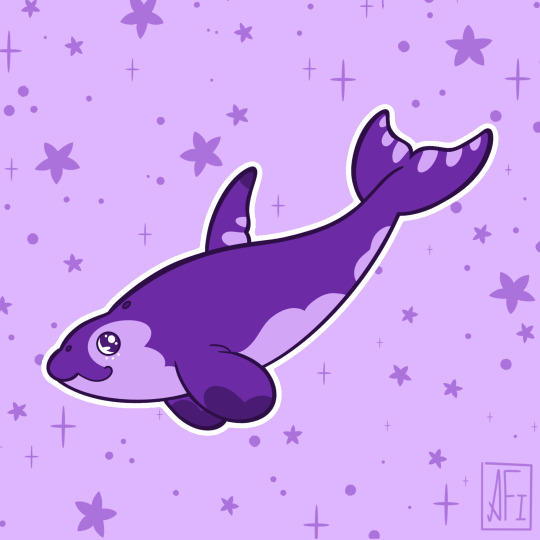
Welcome back to the Paleo Party!
Today’s prehistoric guest is Orcinus citoniensis.
This Pleistocene whale belongs to the same genus as our modern Killer Whales, Orcinus Orca. The Genus Orcinus is first found in the fossil record 11 million years ago, and this species has been found from 3.5 to 2.5 million years ago in Italy and England. They were quite a bit smaller than the modern orca at around 13 ft, and possibly they represent the transition between the modern killer whale and dolphins. While a lot of their bones are more comparable to the modern killer whale, their shoulder blades are short and broad more similar to ancient bottlenose dolphins, especially Turisops capellinii. Their smaller teeth point to a diet of medium sized fish and squids. Particularly in the Pliocene of Tuscany, they likely lived in a transitional area of continental slope alongside other whales Kogia, Echrichtioides, dugongs like Petaxytherium, and the pliocene mega-shark, Megalodon. We have no evidence of predation, but considering their size, they might have been targeted by the mega-shark.
If you’d like your own Orcinus citonensis, you can find them both in my Neogene and Quaternary Era sticker groups, and my Ancient Whales Pack.
35 notes
·
View notes